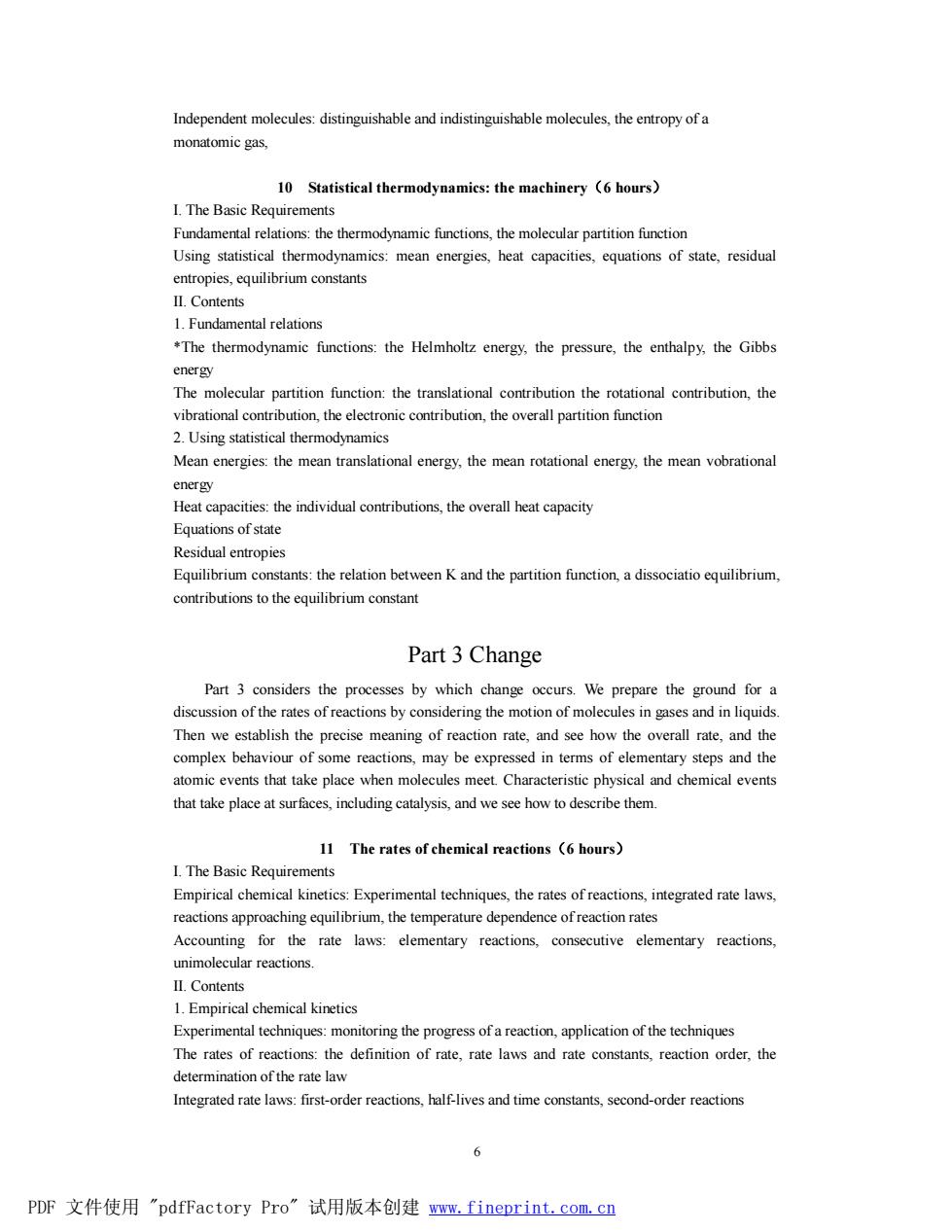正在加载图片...

Independent distinguishableand indistinguishable entropyofa monatomic gas, 10 Statistical thermodynamics:the machinery (6 hours) I.The Basic Requirements Using statistical thermodynamics:mean energies,heat capacities,quations of state,residu entropies,equilibrium constants II.Contents 1.Fundamental relations The thermodynamic functions:the Helmholtz energy,the pressure,the enthalpy,the Gibbs ener gy The molecular partition function:the translational contribution the rotational contribution,the vibrational contribution,the electronicconribution,the overall partition function 2.Using statistical thermodynamics Mean energies:the mean translational energy.the mean rotational energy.the mean vobrational Htelcepeciesteimdvidalcomtnbuhioas,teomealtheacapoci Equations of stat Residual entropies Equilibrium constants:the relation between K and the partition function,a dissociatio equilibrium, contributions to the equilibrium constant Part 3 Change Part 3 considers the processes by which change occurs.We prepare the ground for a discussion of the rates of reactions by considering the motion of molecules in gases and in liquids. Then we establish the precise meaning of reaction rate.and see how the overall rate,and the complex behavio of me reactions,may be expressed n terms f elementary step s and the atomic events that take place when molecules meet.Characteristic physical and chemical events that take place at surfaces,including catalysis,and we see how to describe them. 11 The rates of chemical reactions (6 hours) I.The Basic Requirements Empirical chemical kinetics:Experimental techniques.the rates of reactions,integrated rate laws, reactions approaching equilibrium,the temperature dependence of reaction rates Accounting for the rate laws:elementary reactions,consecutive elementary reactions. unimolecular reactions II Contents 1.Empirical kinetics Experimental techniques:monitoring the progress of a reaction,application of the techniques The rates of reactions:the definition of rate,rate laws and rate constants,reaction order.the determination of the rate law Integrated rate laws:first-order reactions.half-lives and time constants.second-order reactions 6 PDF文件使用"pdfFactory Pro”试用版本创建ww,fineprint.com,cn6 Independent molecules: distinguishable and indistinguishable molecules, the entropy of a monatomic gas, 10 Statistical thermodynamics: the machinery(6 hours) I. The Basic Requirements Fundamental relations: the thermodynamic functions, the molecular partition function Using statistical thermodynamics: mean energies, heat capacities, equations of state, residual entropies, equilibrium constants II. Contents 1. Fundamental relations *The thermodynamic functions: the Helmholtz energy, the pressure, the enthalpy, the Gibbs energy The molecular partition function: the translational contribution the rotational contribution, the vibrational contribution, the electronic contribution, the overall partition function 2. Using statistical thermodynamics Mean energies: the mean translational energy, the mean rotational energy, the mean vobrational energy Heat capacities: the individual contributions, the overall heat capacity Equations of state Residual entropies Equilibrium constants: the relation between K and the partition function, a dissociatio equilibrium, contributions to the equilibrium constant Part 3 Change Part 3 considers the processes by which change occurs. We prepare the ground for a discussion of the rates of reactions by considering the motion of molecules in gases and in liquids. Then we establish the precise meaning of reaction rate, and see how the overall rate, and the complex behaviour of some reactions, may be expressed in terms of elementary steps and the atomic events that take place when molecules meet. Characteristic physical and chemical events that take place at surfaces, including catalysis, and we see how to describe them. 11 The rates of chemical reactions(6 hours) I. The Basic Requirements Empirical chemical kinetics: Experimental techniques, the rates of reactions, integrated rate laws, reactions approaching equilibrium, the temperature dependence of reaction rates Accounting for the rate laws: elementary reactions, consecutive elementary reactions, unimolecular reactions. II. Contents 1. Empirical chemical kinetics Experimental techniques: monitoring the progress of a reaction, application of the techniques The rates of reactions: the definition of rate, rate laws and rate constants, reaction order, the determination of the rate law Integrated rate laws: first-order reactions, half-lives and time constants, second-order reactions PDF 文件使用 "pdfFactory Pro" 试用版本创建 www.fineprint.com.cn